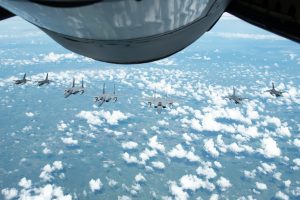The United States has been Thailand’s primary security partner since the end of World War II. The U.S. committed to defending Thailand against the communist threat during the Cold War through the Thanat-Rusk Agreement of 1962. In return for Washington’s security blanket, Bangkok sent more than 37,000 Thai troops to assist the Americans in the Vietnam War from 1965 to 1972 and opened its air bases to U.S. combat aircraft conducting bombing runs across Indochina.
On the surface, defense relations continue to be strong even after the Cold War. The United States designated Thailand as a major non-NATO ally in 2003, while since 1982, both parties have co-hosted the Cobra Gold military exercise series, Southeast Asia’s largest multinational military exercise.
Yet, in recent years, there are signs Thailand is moving closer toward China on defense relations. This trend can partially be explained as the outcome of the 2014 military coup in Bangkok, which overthrew the democratically elected government. Shortly after the coup, the U.S. reduced military cooperation with Thailand, scaling down the size of their joint military exercises (JMEs) and suspending $3.5 million in military aid.
The downgrade in Thailand-U.S. defense relations enabled China to step up to fill the vacuum. Two areas are worth looking at to assess the state of China-Thailand defense relations in recent years.
First is arms sales, an area where China is slowly gaining a foothold in Thailand. While the United States had been the primary arms supplier to Thailand since the Cold War, China has taken over this position since 2016. Between 2016 and 2022, Thailand received more arms in terms of value from China ($394 million) than the United States ($207 million).
According to the Stockholm International Peace Research Institute (SIPRI), Thailand’s arms imports from China since 2014 include big-ticket items such as a submarine (which has been replaced by a frigate), anti-ship missiles, air defense systems and armored vehicles. Chinese weapons are known to be cheaper when compared to their U.S. equivalents allowing budget-conscious Bangkok to acquire defense capabilities at lower costs.
Second, China and Thailand have expanded the scale and scope of their bilateral joint military exercises (JMEs). Undoubtedly, the United States still holds more bilateral joint training and defense dialogue with Thailand. However, China is slowly catching up.
For example, the number of bilateral JMEs between China and Thailand has expanded in recent years. While there was only one JME between the two states in 2017, this has increased to three in 2023, covering the land, maritime, and air domains.
As pointed out by Ian Storey, China-Thailand bilateral JMEs are still less sophisticated when compared to the exercises that the Thai military has with the United States. Storey argued that China’s JMEs with Southeast Asian states are often “performative events; they are more symbolic than substantive. They are often highly scripted, with schedules and outcomes planned out in advance.”
However, that does not mean the scale and scope of China-Thailand bilateral JMEs will continue to be less sophisticated than Thailand-U.S. ones, especially in the long run. Some of the bilateral JMEs are already substantive rather than just performative exercises. The Falcon Strike Exercise series involving the air forces from China and Thailand, first held in 2015, is one such example. This series of JMEs is more complex and has seen the participants allocating more resources over the years.
The first Falcon Strike Exercise in 2015 saw combat maneuvers between the Chinese J-11s and Thais Saab Gripen combat aircraft over seven days. The latter emerged as a winner, revealing Chinese pilots’ weaknesses in dogfight techniques. China’s People’s Liberation Army Air Force (PLAAF) took the outcome of that first exercise seriously, sending different types of combat aircraft to participate in the following years.
Furthermore, China invested more resources into the series over time, featuring early warning aircraft (AEW), bombers and air defense units, perhaps reflecting the exercise series’ importance in sharpening the skills of its pilots.
The utility of the Falcon Strike series of exercises to the Chinese is not lost on the Americans, who prevented Thailand’s military from deploying the Thai air force’s U.S.-built F-16 combat aircraft to participate in the exercises.
Nevertheless, Thailand’s overall bilateral JMEs with China are still less complex than those with the United States. Bilateral land JMEs focus primarily on counterterrorism. In the maritime domain, the scope of the exercises is more akin to confidence-building efforts involving activities such as search and rescue and cross-deck helicopter landings.
The U.S. will remain Thailand’s primary security partner in the short term. But given the Chinese efforts to step up defense engagement with the Thais and the complexity of Thailand-U.S. relations overshadowed by the former’s domestic politics, there is always the possibility that China may supplant the United States as Thailand’s primary security partner in the long run, further diluting U.S. influence in Southeast Asia.
































